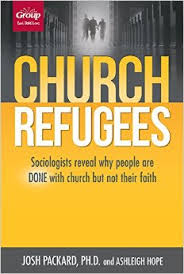Josh Packard and Ashleigh Hope
In One Hundred Words: Two sociologists study the Dones: people who are walking away from church, often after a lifetime of commitment. They examine the reasons why the Dones left, (e.g. judgmentalism, bureaucracy, inflexible doctrine, lack of meaningful ministry), how their exit is a result of their commitment to their faith, and what churches can do to bring them back.
Who Should Read It: Lifelong church people – both laity and pastors.
How Long?: A very easy, not-at-all-technical 140 pages.
——————
Josh Packard and Ashleigh Hope are not radical firebrands. They are restrained sociologists. They open the book with a detailed explanation of their methodology. They are highly respectful of their subjects, letting them speak in their own words as much as possible. They are careful not to draw sweeping conclusions.
All of this makes the picture they paint in Church Refugees that much more surprising and disturbing. The book is the product of hundreds of interviews with the “dechurched” or the “dones”, people who “make explicit and intentional decisions to leave the church and organized religion.” (14) They reveals that the dones are not the people many of us thought they were. These are not those who left because the pastor started using too much contemporary music or because their favorite knitting circle shut down. These are not the perennial church-hoppers, who change communities like other people change socks. The dones are deeply committed Christians: people who gave the institution their all ,often for decades, and who left because of their faith.
Church Refugees explores what caused the dones to make that decision. It groups their reasons into four chapters. First is “Community and Judgment”, which explores the dones’ deep desire to experience authentic, non-judgmental spiritual community. Second is “Activity and Bureaucracy” which describes the way that church structure actively prevented the dones from living out their calling. Third is “Conversation and Doctrine” which details the done’s desire to have meaningful, honest, open conversations about faith and life where there isn’t an orthodoxy that everyone has to unthinkingly adhere to. Finally is “Meaningful Ministry and Moral Prescription” which shares how the dones’ experience that the church was more concerned with “policing personal morality” than healing society, especially in regards to poverty.
The stories are often heartbreaking. Among them is Kate, a passionate, extremely gifted Christian who wanted to start an art-therapy after school program.
At first, she was hoping for some support from her congregation for supplies and materials, but eventually asked simply for space to meet….The church council took a vote, and, on the pastor’s recommendation, decided not to support the work she was doing because the kids weren’t members of the church and might not even be Christians…Eventually, Katie decided to start the organization as a non-profit, and ultimately left her congregation. [She says] ‘It just got to the point that it was so painfully obvious to me that the art therapy was making more of a real impact in the world, and was feeding me more spiritually as a group of people committed to relationships than my home congregation had ever done. (58-59)
As a church person, this book is a hard mirror to look into. Any long-time church person recognizes this behavior. Truth be told, we often perpetuated it. We tell jokes about it,[1] excuse it as inevitable,[2] and even actively defend it.[3] It’s become normal.
All those ugly stories that we sweep under the carpet? In this book, we hear all of them and are reminded that our justifications leaves bodies behind.
In the final chapters, the authors make the obligatory pivot to suggesting what can be changed to get the dones to come back (or never become done at all.) Their suggestions, taken in isolation, are good, such as undermining bureaucracy by putting end dates of programs or staff responsibilities that would otherwise exist forever, or using asset-based community organizing to empower people to use their gifts. However, in doing so, they sidestep the elephant-sized ecclesial question that their study raises:
What if the dones are right?
What if much of what we call church is just a highly efficient way for us to hide from God?
What if the vast time and energy that we spend in maintaining our institutional structures is not really about faithfulness, but about choosing to leave hungry people unfed, naked people unclothed, sick and imprisoned people unvisited?[4]
What if the dones are leaving, not because they’re burnt out on church, but because they’re brave enough to search for a true expression of church outside of the institution?
Perhaps the dones have not left the church, perhaps it is us institutionalists who have left the church, maybe even generations ago, and just never realized it.
In the end, the book left me wondering, do we really need to engage with the dones to get them back, or should we just follow them out into the future?
Then again, maybe that’s a rabbit hole too terrifying to jump into.
[1] How many Methodists does it take to change a light bulb? One to change the light bulb, and three committees to approve the change and decide who brings the potato salad and covered dishes.
[2] “Of course the church isn’t perfect, it’s made of people!”
[3] “We have to do it this way, it’s what the Book of Discipline requires and we are a connectional church who practices covenantal accountability!”
[4] See: Matthew 25:31-46. Jesus doesn’t say much about worship services, committee meetings, or denominational gatherings.

